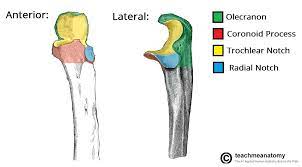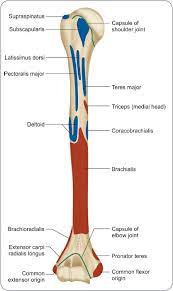LEFT ULNA
What is the ulna? The ulna is the longer of the two bones in your forearm. It helps you move your arm, wrist and hand. Your ulna also supports lots of important muscles, tendons, ligaments and blood vessels.

RIGHT RADIUS
Where is the radius located? Your radius is one of two bones in your forearm. The other is your ulna. The radius is opposite your ulna, on the lateral (thumb) side of your forearm. Your radius rotates over your ulna when you stretch your arm straight out in front of you with your palms facing down.
LEFT HUMERUS
The humerus is the largest bone of the upper extremity and defines the human brachium (arm). It articulates proximally with the glenoid via the glenohumeral (GH) joint and distally with the radius and ulna at the elbow joint
LEFT CLAVICAL
The clavicle is a sigmoid-shaped long bone with a convex surface along its medial end when observed from cephalad position. It serves as a connection between the axial and appendicular skeleton in conjunction with the scapula, and each of these structures forms the pectoral girdle.
RIGHT ULNA
The ulna (pl. ulnae or ulnas) is a long bone found in the forearm that stretches from the elbow to the smallest finger, and when in anatomical position, is found on the medial side of the forearm. That is, the ulna is on the same side of the forearm as the little finger.
LEFT RADIUS
The radius or radial bone is one of the two large bones of the forearm, the other being the ulna. It extends from the lateral side of the elbow to the thumb side of the wrist and runs parallel to the ulna.
Right humerus
 The humerus articulates with the scapula proximally at the glenohumeral joint so it participates in the movements of the shoulder. Also, the humerus has distal articulations with the radius and ulna at the elbow joint.
The humerus articulates with the scapula proximally at the glenohumeral joint so it participates in the movements of the shoulder. Also, the humerus has distal articulations with the radius and ulna at the elbow joint.
Right clavical
The clavicle is a sigmoid-shaped long bone with a convex surface along its medial end when observed from cephalad position. It serves as a connection between the axial and appendicular skeleton in conjunction with the scapula, and each of these structures forms the pectoral girdle. 
